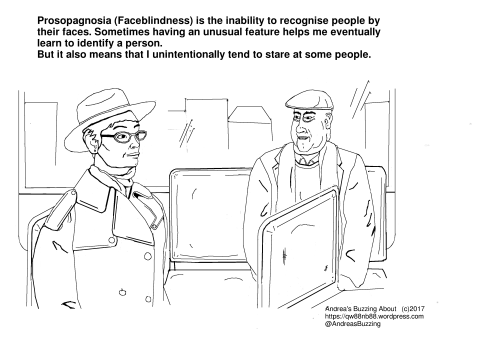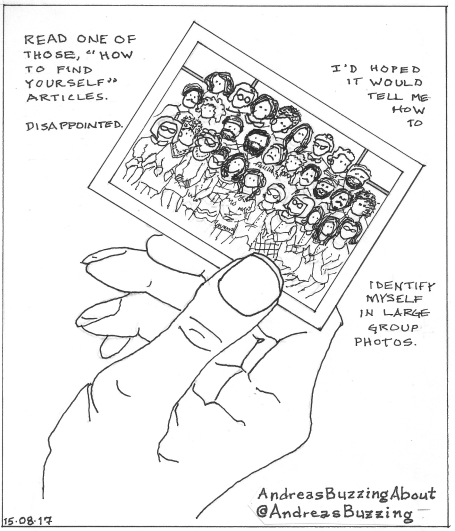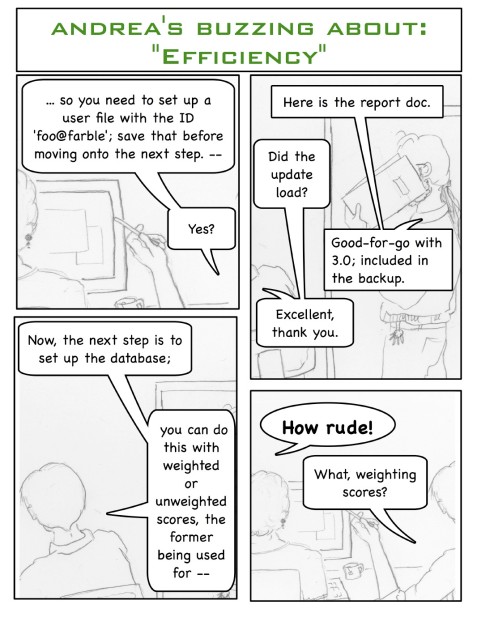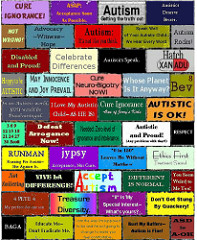[* THIS POST IS A PART OF BLOGGING AGAINST DISABLISM DAY 2010]
Or perhaps, just deliver an explanatory document to my boss and the HR (Human Resources) person at my second job.
My annual review was okay; very good on some things, okay on others, some recommendations (there always are — no one is perfect after all). But something mentioned was to get to know the regular customers by name. I have, after all, been here a year, and grocery stores have a core set of regular customers that come through once, if not several times, a week. It’s not hard to learn names when you’re checking them out, as the names appear on their check or on the register (till) screen when they use a debit or credit card.
But of course, most people have no difficulty distinguishing or remembering faces.
I on the other hand, have that lovely invisible disability of prosopagnosia, or face-blindness. I don’t recognize people by their faces. I cannot easily or quickly identify people. And, I cannot remember faces. Sure, I’ve learned to (consciously, relatively slowly) identify a core set of the people with whom I work regularly. I know my immediate bosses, the store manager, some of the other managers, and several of the checkers and sackers, a few stockers, and one each of several butchers, florists, pharmacists, and cooks.
But they are likely less than 25% of the total employees. I’m not sure how many there really are, because part-timers tend to come and go, and also, to me the other employees form a general mass of generic persons, all of whom follow the same prescribed dress code.
Ah yes, the dress code. The great thing about jobs I have is that the school and the grocery both require people to wear name tags. Not only can I be sure with whom I’m speaking, but they also allow me to check and memorize the names once I have figured out how to identify that person regularly. Whee!
But, unlike the school, the grocery has a dress code. It’s not overly fastidious, just along the lines of slacks + collared shirt, except when we are to wear a specific color of shirt on Fridays & weekends. Of course, there’s a down side — when I need to find say, my assistant manager to ask him a question, there’s an entire giant supermarket just riddled with people in blue button-down or polo [golf, tennis] shirts — and some of those are customers!
I cannot just glance over a crowd of people and instantly spot the person I need. They don’t “pop out”. (No, not even my family members!) Instead, I must examine each person and compare their overall size, haircut, gender, and coloration to my mental gestalt. Of course, it’s easier if I’m looking for say, a taller, brown person — that means I only have to scan each aisle for (1) blue shirts, (2) tall people, (3) brown-skinned people, and (4) the particular haircut, gait and voice that is one of the assistant managers.
That sounds fairly easy, or at least efficient, right? But that’s still walking down some 15+ aisles and side-aisles, visually sorting each adult-size person. And quite possibly the guy’s in the back scanning office or stock room or upstairs office or break room or in a restroom or retrieving something from the outside loading dock or where-ever-the-hell managers go when they go poof and disappear.
Thank heavens I can get on the intercom and page him to call extension 137 or whatever. In turn, when I’m needed to be an extra checker or to meet with someone, the various managers have been very nice about paging me by my name-and-department or by my whole name. I’ve not really bothered to explain the whole Auditory Processing Disorder thing; I’ve just said that it’s hard for me to understand the pages sometimes, especially if my head’s down in a refrigerated case with its noisy fans, or I’m in the back room pulling stuff out of shipping cartons.
But you know, it’s difficult to explain faceblindness in 25-words-or-less. No one’s heard of it, and the fact that I can in some manner still identify some people enough of the time makes it even more baffling to people. And of course, there’s the old, “Oh, I have trouble remembering names and faces sometimes, too.”
Well, yeah. But you still recognize people, in a split-second of unconscious thought. You are aware that you know these people. You may even know where you know all those people from. You just have trouble remembering the names that go with those faces.
I never do. And except for the couple-dozen very morphologically distinctive customers, I’m not likely to remember any of them.
Silly people, they keep changing their physical characteristics, wearing different clothes through the seasons, changing their hairstyles, their purses, their hats or glasses, and so on. Sometimes they have family members with them, and sometimes not. Their children have this incredible ability to grow and morph dramatically. And of course, the customers keep changing the details of how they interact with me, and will need my help finding something in one aisle or another, or check out at different times of day, or whatever. Good heavens, sometimes people whom I know from other parts of my life will come through — the pharmacist will be shopping in their street clothes instead of standing behind their counter in a lab coat, my neighbor, or a former student will greet me, and they usually expect me to know them when they are out of their usual environments. (At least my ophthalmologist understands that I’ve hardly ever seen him with my glasses on.)
Alas, the world is too full of generic people seen on an intermittent basis. Once in a great while, somebody comes by to ask me a question, and it isn’t until they begin to speak to me that everything clicks, and I realize this is my daughter or son-in-law!
I’m really quite helpful to customers, am conscientious about getting the stock rotated and shelved with the right price tag, do a great job of setting up displays, make a point to be sure that the back stock is checked so it gets on the floor, am careful when bagging so the cold items are together and the eggs are all okay and the bread and produce doesn’t get squished, and so on.
It’s just that I will never be able to learn very many customers, or even all the employees. And much as I would like to have this magical skill that 98% of the rest of the population has, my disability is far outweighed by all the other things that I can do well. I’m not lazy or stupid. It’s just that I have an invisible disability.















You must be logged in to post a comment.